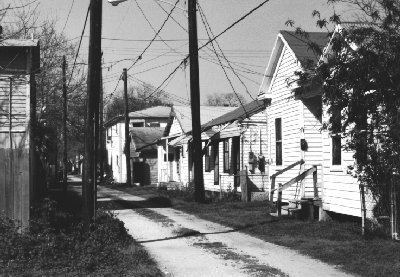In Galveston's Alley
Today, walk with me through Galveston's alleys. The University of Houston's College of Engineering presents this series about the machines that make our civilization run, and the people whose ingenuity created them.
If you live in a house, your back lot probably ends at the fence of the neighbor behind you. City blocks are normally two lots wide with nothing in between. But they weren't always. Go into an old enough part of your city and, if it's still intact, you're apt to find an alley running down the center of each block.
When I was kid, regular deliveries were made from the alley -- coal for the coal chute, groceries. Ice for our ice box came down the alley on a horse-drawn truck. The garage faced into the alley.
The old city of Galveston was laid out that way with its wide blocks severed by alleys. Galveston was a wealthy port city before the Civil War, and so it continued into this century.
The old mansions are still there. Some are historic sites, some are private homes, some are bed and breakfasts. And, in back, the old alleys are still there as well -- with the same sort of small buildings that've lined them for a century and a half.
Architectural historian Ellen Beasley began taking an interest in those houses years ago and, as she did, they teased her curiosity and grew into a full-time commitment [1]. Those little houses were once slave quarters, then servant's quarters. They gradually became low-cost housing stirred right into the heart of the city. In the hard years after WW-I, they were the mixing ground among black and white, rich and poor.
Walk the alleys of Galveston today, and you'll find a stunning blur of architectural style -- shotgun houses, slim two-story buildings that house a garage below and a family above.
We have statistics from 1900 -- the year the great hurricane struck Galveston and killed some 8000 people. Three out of four of the thousand alley dwellers were black at the time, the rest white. A few of the present alley houses were ones that survived the storm and were jacked up when Galveston built a sea wall and raised the ground level eight feet.
The alleys have been alternately dirty and clean. When Galveston suffered an outbreak of bubonic plague in 1920, the city went into the alleys killing rats and doing massive cleanup. Before that, a building code had eliminated anything you'd call a shack. These homes may've represented the lowest leg of Galveston society, but the alleys prevented the poor from being ghettoed they way they are in larger cities.
This old way of life is a direct spin-off from the days of slavery. Yet it has mutated into something far more humane. The children play together -- and that heals wounds in ways no federal program ever could. Beasley finishes her book with a poignant photo -- it shows a telephone pole with a hand-lettered sign on it says OUR ALLEY IS KATHARO. The Greek word katharo means cleansed. There is pride of place here. And there is community.
I'm John Lienhard, at the University of Houston, where we're interested in the way inventive minds work.
(Theme music)
1. Beasley, E., The Alleys and Back Buildings of Galveston: An Architectural and Social History. Houston, TX: Rice University Press, 1996. Distributed by Texas A&M Press, College Station, TX.
I am grateful to Ellen Beasley for taking me on a tour of Galveston's alley houses and for her counsel on this episode.

An Alley Scene in Galveston, Texas
Photo Courtesy of Ellen Beasley